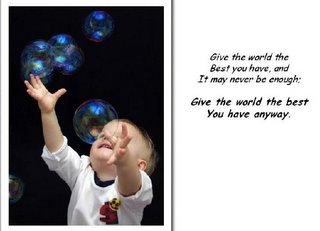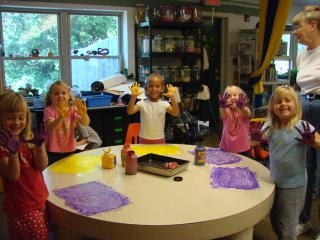When other kids their age started kindergarten last month, 5-year-old Caitlin and Jackson Pilisuk just waited on the sidelines.
The Oakland twins were eligible, but their parents and preschool teachers decided they weren't ready "emotionally to deal with the rigors of kindergarten," said their mother, Philippa Barron. So the twins will stay in preschool and start kindergarten at age 6.
Evan Swihart, on the other hand, is happily plugging away in his Walnut Creek kindergarten class at age 4.
"After a few days, we got the sense that he's in the right spot after a whole year of worrying and fretting about it," said his mother, Christine.
An estimated 9 percent of children nationally are entering kindergarten a year later than they could, though there's little evidence that children perform better in school if they start late. This practice has become common enough to earn the nickname "redshirting," borrowed from a term for college athletes who don't play in their freshman year in order to spend the time building their strength and skills.
For kindergarten, boys are twice as likely to be redshirted as girls, whites are redshirted more than minorities, and middle-class and more affluent students are more likely than poorer ones to delay, according to studies by the U.S. Department of Education's statistics center and other researchers. As kindergarten becomes more academic and schools move to full-day programs, whether to redshirt has become a hot topic -- and great source of stress -- for parents with the means to pay for an extra year of day care or preschool.
The situation is exacerbated in California because its requirement that kindergartners be 5 years old by Dec. 2 is one of the five latest cutoff dates in the nation. Thus, a single kindergarten class can include old 4-year-olds, 5-year-olds, and young 6-year-olds, and many teachers say that creates a developmental gap that is hard to bridge.
But experts worry that redshirting puts low-income students at an extra disadvantage. The children who end up going to school young because their parents can't afford to hold them back are also the ones with the least preparation and lowest rates of participation in preschool, they say. Then those children to have to compete with older, better prepared students whose parents may demand more challenging classrooms so their kids aren't bored.
State Sen. George Runner, R-Lancaster (Los Angeles County), has authored legislation each year for the past decade to move up the state's cutoff date to Sept. 1. He said his bill finally gained traction last session, when it passed through every committee with support from the California Teachers Association, the state PTA and the California School Boards Association.
Twenty-two states moved up their cutoff dates between 1975 and 2000, said Deborah Stipek, dean of Stanford University's School of Education; 37 now limit kindergarten to kids who are 5 years old by Sept. 30 or earlier.
Comparison of test scores among states is helping drive the change.
"I think people are recognizing our curriculum is different than it was 10 or 15 years ago," said Runner, who founded a private school before becoming a legislator. "We constantly found our (students with) fall birthdays, particularly the boys, were the kids who were struggling."
If passed, Runner's bill would move up the cutoff one month each year for three years, starting with the 2008-09 school year. The sticking point has been figuring out how to handle its financial impact, because the number of kindergartners could drop by one-fourth over the phase-in years, which would result in less per-pupil state funding for schools.
But holding children back from kindergarten could have unintended consequences.
Stipek, who has studied the issue, said the academic benefits that redshirted kids see early on generally disappear by third grade. Some studies also suggest children who are "over age" for their grade are more likely to have behavior problems and to drop out later.
Stipek, who opposes changing the cutoff, is concerned that low-income students -- who she believes would benefit more from a year in school than another year at home -- lose from redshirting, whether they or their classmates are held back.
"Unless you ensure kids have access to high-quality preschool, you are putting disadvantaged kids at a greater disadvantage," she said.
A study published this summer by researchers at the University of Southern California and the University of Texas at Austin found that redshirted students were less likely to repeat kindergarten and subsequent grades but didn't see any long-term academic or social benefits.
Many kindergarten teachers insist that age makes a difference.
"I can tell which kids are ready to sit on the rug, which ones don't need to cling to Mom and Dad. I can tell by their interest and their ability to focus," said Los Angeles teacher Armando Argandoña, president of the California Kindergarten Association, whose members voted this year to make changing the cutoff its top priority.
"I don't want to say every 4-year-old will have trouble, but 90 percent of them have a hard time getting started, even the children who have had preschool," said Santa Rosa teacher John Eberly. In his class of 19, he said, the three students repeating kindergarten this year entered last year as 4-year-olds.
Skills that were taught in first grade when he started in the field 14 years ago -- such as reading short words and understanding addition and subtraction -- now are expected in kindergarten, and homework often is assigned.
Other factors often come into play, too.
"The issue for us was not kindergarten but later in life when things become more challenging academically and socially," said Veronica Altschul of Kensington, whose first-grader, Eric Ingersoll, turned 7 on Sept. 12. Her daughter also will start kindergarten at age 6.
Altschul, who called the decision "12 months of agony," thinks that her children will be better prepared to make decisions on issues from sex to drugs and that they will get more out of college.
"What's the rush? Why not give them another year of play?" she asked.
Eve Pearlman of Alameda, who is happy with her 6-year-old's experience entering kindergarten at age 4, nonetheless would like to see the cutoff date moved up.
"If you're thinking about just your kid, and your kid is a year to a year and a half older, you're not taking into consideration the whole group," Pearlman said. "I'm not so sure being the biggest and the best is necessarily good for a kid. I think being challenged is pretty good."
Kindergarten goals California's Department of Education sets specific goals that students must meet before being promoted to the next grade. These are a few of the math, reading and writing goals for students completing kindergarten:
Read simple one-syllable, high-frequency words.
Write words and brief sentences that are legible.
Write uppercase and lowercase letters of the alphabet independently.
Understand and follow one- and two-step oral directions.
Count, recognize, represent and order numbers up to 30.
Identify and describe geometric objects.
Identify time to the nearest hour of everyday events (e.g., bedtime is 8 o'clock).
Directly compare the length, weight and capacity of objects (e.g., this one is shorter).
Comment: This is an interesting article and shows us what people think about outside our little healthy environment.






















